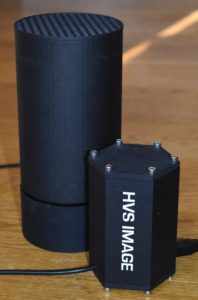 HVS Image is a pioneer in the Atlantis platform method developed from Burešová original on-demand platform and we now offer a highly refined enhancement of the original electro-pneumatic design.
HVS Image is a pioneer in the Atlantis platform method developed from Burešová original on-demand platform and we now offer a highly refined enhancement of the original electro-pneumatic design.
- Rises automatically when subject reaches or dwells at the target position for the length of time you define.
- Standard 10cm diameter. Adaptors available but note that target area diameter can be set independently of submerged platform diameter in HVS Image tracking system.
- Easy-grip top.
- Platform vertical range: 23-35cm.
- Silent operation.
- No air compressor to give acoustic cues.
- Electrically safe. Instant actuation. Low voltage electrics. No mains connection.
- Available for use with HVS Image tracking and analysis system, as a single platform or in an array of four units.
[With the Atlantis Platform] Data show[ed] significantly improved localization of rats trained to the Atlantis platform compared with those trained to the regular hidden platform. Examination of the paths taken in individual transfer tests illustrate the exceptionally focused searching [in] the exact area of the platform. [Subjects] can learn the spatial location of the platform, and remember to stay there, rather than merely developing effective nonspatial search strategies [1]
When assessing spatial learning and memory with the Morris water maze, one potential limitation is that subjects may use a strategy to find a non-rising platform progressively faster without learning its spatial location in relation to the cues. For example, on learning that a platform is a certain distance away from the side of the pool, the subject can develop the strategy of circling around the pool at approximately the correct distance from the side, in order to find it on the way round. The accuracy of the distance from the poolside improves over the training trials, giving reducing escape latencies, which may be wrongly interpreted as spatial learning.
Furthermore, in probe or transfer tests, if a non-rising platform has been used in training, and probe trials are then carried out with the platform removed, subjects with strong spatial learning and memory may swim straight to the learned location at the start of the probe trial, learn and remember that it is no longer there, and spend the remainder of the trial searching the pool as a whole rather than the target area. Without sophisticated analyses the strongest (or fastest) spatial learning could easily be unseen in overall probe test results.
The HVS Image analyses will reveal true spatial learning (or other strategies) in both the above cases; use of the Atlantis platform, which sits well below the surface and rises when the subject reaches or dwells at the target location, will ensure that spatial learning, rather than other strategies, has to be used to find the target location.
The non-rising regular platform (or the Atlantis pre-risen) will be needed if you want to discover which strategies your subjects use when all options are available, along with our sophisticated analyses to reveal the type of learning or strategies in use in training and probe trials.
The rising Atlantis platform will be needed if you want to encourage spatial learning, or determine whether your subjects can use spatial learning at all, even if it is not their first choice method.
To determine both the method of preference and the degree of spatial learning achievable, both non-rising and rising platform trials will be needed.
When Atlantis has been used in training, and subjects have been required to dwell at the target location in order for it to rise, it should also be used in probe tests: it will not be found by chance, since subjects that have not learned the location will not be lingering there, in which case it will not rise. In contrast, subjects that have learned to dwell at the target location will continue to be rewarded with the automatically rising platform, allowing spatial learning to be observed and analysed easily, including direct comparison with training trials.
Contact us to purchase or find out more.